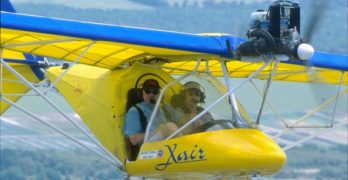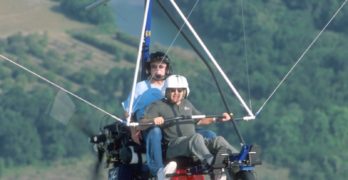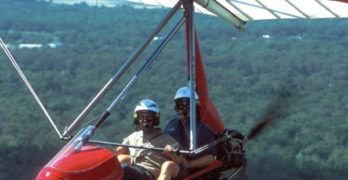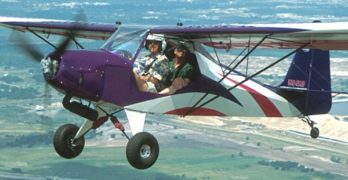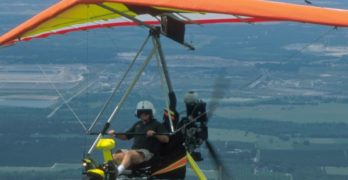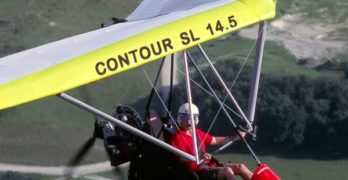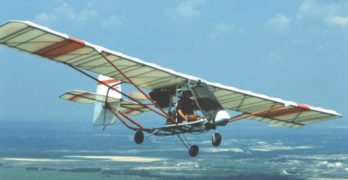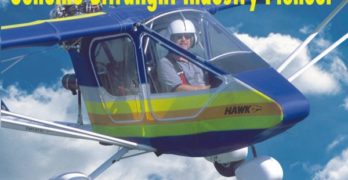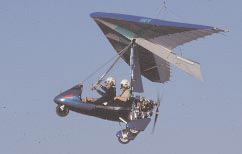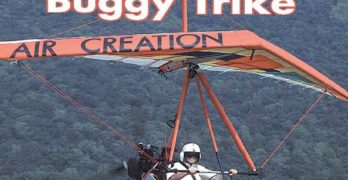he Xair hardly looks like a Weedhopper anymore. And its French-based producer, Randkar, may no longer care to associate with the pioneering design (though they surely wouldn’t mind selling 4,000 units like the Weedhopper). Indeed, the machine is now so different, the heritage barely reveals itself.
Today, it may take a stretch of imagination to see the Weedhopper under the Xair’s fancy new coverings. To try, let your mind’s eye take away the entire cockpit assembly and the aft fairing. What you’re left with does begin to look like a Weedhopper. The swept wing with its long chord, the simple, angular tail… it’s clearly a derivative of John Chotia’s Weedhopper.*
Global Contender
Created in America, the Weedhopper migrated to Europe (where more than one company picked up on the simple ultralight). One of those companies is France’s Randkar, which produces the Xair. It is built by an Indian company, Raj Hamsa, and returned to American soil by its U.S.
Search Results for : Flight Design
Not finding exactly what you expected? Try our advanced search option.
Select a manufacturer to go straight to all our content about that manufacturer.
Select an aircraft model to go straight to all our content about that model.
Simple, But Efficient – The TC Trike
The itch returned. In truth it never left, says TC’s Trikes owner TC Blyth.
“I was a hang glider pilot 20 years ago and when the time was right, I wanted to jump back in,” says Blyth.
But instead of returning to hang gliding, trikes are the machines Blyth chose to reinvigorate his flying. A Chattanooga, Tennessee native, Blyth’s familiarity with tailless delta wings stimulated him to get involved with trikes.
After his earlier time enjoying hang gliding, family and work responsibilities “interfered” with this enjoyment for many years. Many ultralight enthusiasts can understand this situation. In the interim Blyth took up fishing, but he says, “Stumbling around among rocks in moving water had hazards, too. You can trip and fall, and drown.” While he enjoyed fishing, he figured the risks of flying weren’t overwhelming and he itched to fly again.
Blyth started by representing Sabre Aircraft and reports selling many trikes for the Southwestern company.
South Africa’s Aerotrike Goes First Class
First came the Aerotrike. Travelling all the way from South Africa where Rainbow Aircraft manufactures it, the Aerotrike looked to be – and is – a very sturdy trike that could stand the rigors of flight instruction. However, some thought it lacked the finesse of the finest European trikes.
Designed by Mike Blyth, the Aerotrike was built precisely for the purpose of flight training. For years, Blyth had used other brands of trikes in his flight school. However, he found they wore out prematurely. This is never a good thing to a school trying to fund itself by teaching many students.
The Aerotrike’s Scout and Safari models proved to be durable flying machines. Former American representative Rob Rollison fitted his Aerotrike with a reliable HKS 4-stroke engine and proceeded to fly a lengthy 2,000-mile journey around Mexico. Not everyone would tackle such a venture, but Rollison says the HKS and his sturdy Aerotrike gave him the confidence to simply fly and enjoy.
Sky Raider Goes Tandem
Part-Time 2-Seater
Like the Kolb FireStar II, the Sky Raider II has a second seat for occasional use – but not for flight instruction. After flying with 165-pound Grant Rappe – a long-time Sky Raider pilot – as my volunteer rear seat passenger, I feel that two big fellows won’t fit. And even with small rear-seat occupants, you probably won’t want to fly for too long. Nonetheless, if you want a ride-along jump seat for occasional use, but you truly prefer single-seat handling and you don’t want to pay a bundle extra for the second seat and dual controls, the Sky Raider II might be for you.
Admittedly you have other choices in this vein. French trike maker Air Création addressed it with their Buggy. Here’s a 2-seat aircraft, which the manufacturer says is mainly intended for single-place operation. The New Kolb Aircraft Company has two models that can do this (the FireStar II and Slingshot II) and of course, the very similar Rocky Mountain Wings Ridge Runner Model II also works much like a Sky Raider II.
South African Star
Not long ago, Americans couldn’t buy products from South Africa because of that country’s apartheid policies. Our government employed economic sanctions that kept South African aviation developments off our radar. However, as their ultralight producers did business with Europe, the Southern Hemisphere country kept up with ultralight aviation despite the sanctions imposed by the United States.
One South African ultralight product is the Aquilla, a sturdy trike from Solo Wings in South Africa.
If the name Aquilla sounds vaguely familiar and a bit Italian to you, go to the head of the class. You’d be right on both counts. Aquila – spelled with one “l” – is a constellation in the Northern Hemisphere and the Milky Way. Exactly how a star in the northern skies inspired someone in South Africa I don’t know. Aquila is also a city of central Italy northeast of Rome.
Nonetheless, Solo Wings owner Aidan De Gersigny, who has been involved with hang gliding since the late 1970s, says Aquilla means “Eagle” in Latin, a name he used for a hang glider he sold 15 years ago.
North Wing Prepares the Apache Sport
Trike and trike wing manufacturer North Wing Design has debuted a new trike called the Apache Sport. Developed for the proposed Light-Sport Aircraft category, this new 2-seater can also be operated as an ultralight trainer qualifying under the training exemption to FAR Part 103.
Barely a year after the new millennia dawned, North Wing Design introduced their first new 2-seat trike to the ultralight community – the original Apache. In the last year of the old century, the Washington-based company offered their first trike – the single-seat Maverick with its distinctive strutted wing.
Prior to these developments, North Wing Design was a trike wing supplier. For many years, small manufacturers of trike carriages have been buying wings from North Wing because they handle and perform handsomely. In a still-earlier role, the company was a savior to owners of certain brands of hang gliders whose manufacturers had left the business.
North Wing came to the aid of these stranded owners.
Slipstream Industries’ Simple Scepter
To many observers, SlipStream Industries is a different ultralight company. As they exhibit in the ultralight areas of big airshows, we know their heart is in the right place (as far as Ultralight Flying! readers are concerned anyway). But they also make twin-engine aircraft.
One way SlipStream distinguishes itself among all light aviation enterprises is by offering not one, but two twin-engine aircraft. The line-up includes the SkyBlaster, which was recently renamed Gemini Twin to differentiate the name from SkyQuest, SlipStream’s other twin. Gemini Twin is a rare fore-and-aft arrangement using two 50-hp Rotax 503 engines. Certainly it is the only one with this configuration in the ultralight field and it draws some analogy to the famous Cessna Sky Master. Hence its closely related former name.
Before the SkyBlaster/Gemini Twin, SlipStream developed and still sells another twin, the SkyQuest. Like its sibling, this twin aft engine pusher design uses the ultralight-standard 50-hp Rotax 503 dual carb as powerplants.
Hawk (at 20 years)
The nation is focused on the celebration of 100 years of powered flight, thanks to efforts by a couple of Ohio brothers in 1903. But ultralight aviation has its own bigger-than-life hero from yesteryear and he’s also from Ohio.
Chuck Slusarczyk needs no introduction because almost everyone involved with ultralight aviation for any length of time knows the jolly designer of the Hawk series of ultralights.
Chuck first flew gliders just as did Orville and Wilbur Wright. Like the famous Wrights, he ignored those who said he couldn’t do what he hoped to do – in Chuck’s case, bring to market an ultralight that broke new ground in several important ways. For one, you had no chance to foot-launch it.For those who became ultralight enthusiasts more recently, the rule in the early 1980s – before passage of FAR Part 103 – was that ultralights had to be foot-launchable. When Slusarczyk first introduced the Hawk, a demonstration of foot-launching was required; since the Hawk was fully enclosed, the pilot could not provide the demonstration, if asked.
Light Sport Aircraft – What you may fly!
The FAA’s new sport pilot/light-sport aircraft notice of proposed rulemaking (NPRM) has been released. With a 90- day comment period underway, the proposed pilot certificate and aircraft categories are on the minds of all light-aircraft producers and anyone who flies for fun. The flying machines that will fit under the proposed new aircraft categories will be called light-sport aircraft, and in this article we’ll take a look at what’s currently available|and what the future may hold.
“The FAA’s new rule is destined to globalize the light aviation industry.”
The promise is great for Americans. When the new sport pilot/light-sport aircraft NPRM changes are finalized and implemented, we will enter a new era in light aviation. People who have wanted a light aircraft to fly for fun but who didn’t have the time or skill to build it will be able to buy a ready-to-fly airplane. And, they’ll be able to learn to fly in less time and at less expense than the cost of acquiring a private pilot certificate.
Buggy + XP
Red is the best color for marketing reasons I was told by a Detroit car marketing executive with a half million a year salary. If you’ve seen a Chrysler TV ad recently, you can see they painted all the cars and trucks bright red.
Published in Light Sport and Ultralight Flying
Seating
Single- or 2-seat
Empty weight
386 pounds
Gross weight
772 pounds
Wingspan
30 feet
Wing area
135 square feet
Wing loading
5.7 pounds/sq ft
Wing
Trike
Height
11 feet 7 inches
Fuel Capacity
9.9 gallons
Kit type
Assembly
Build time
30-60 hours
Standard engine
Rotax 582
Power
65 horsepower
Power loading
11.9 pounds/hp
Cruise speed
56-74 mph
Never exceed speed
87 mph
Rate of climb at gross
1,477 fpm
Standard Features
Twin trike carriage, XP 12 double-surface wing, weight-shift control, hand and foot throttles, steerable nosewheel (push-left, go-right) with brake and mudguard, parking brake, wheel pants, pneumatic suspension, instrument panel, lap seat belt, regulator, water temp, Rotax C gearbox, intake/exhaust silencers, full fairing with windshield, 3-blade composite prop, back seat storage.
- « Previous Page
- 1
- …
- 139
- 140
- 141
- 142
- 143
- …
- 148
- Next Page »


